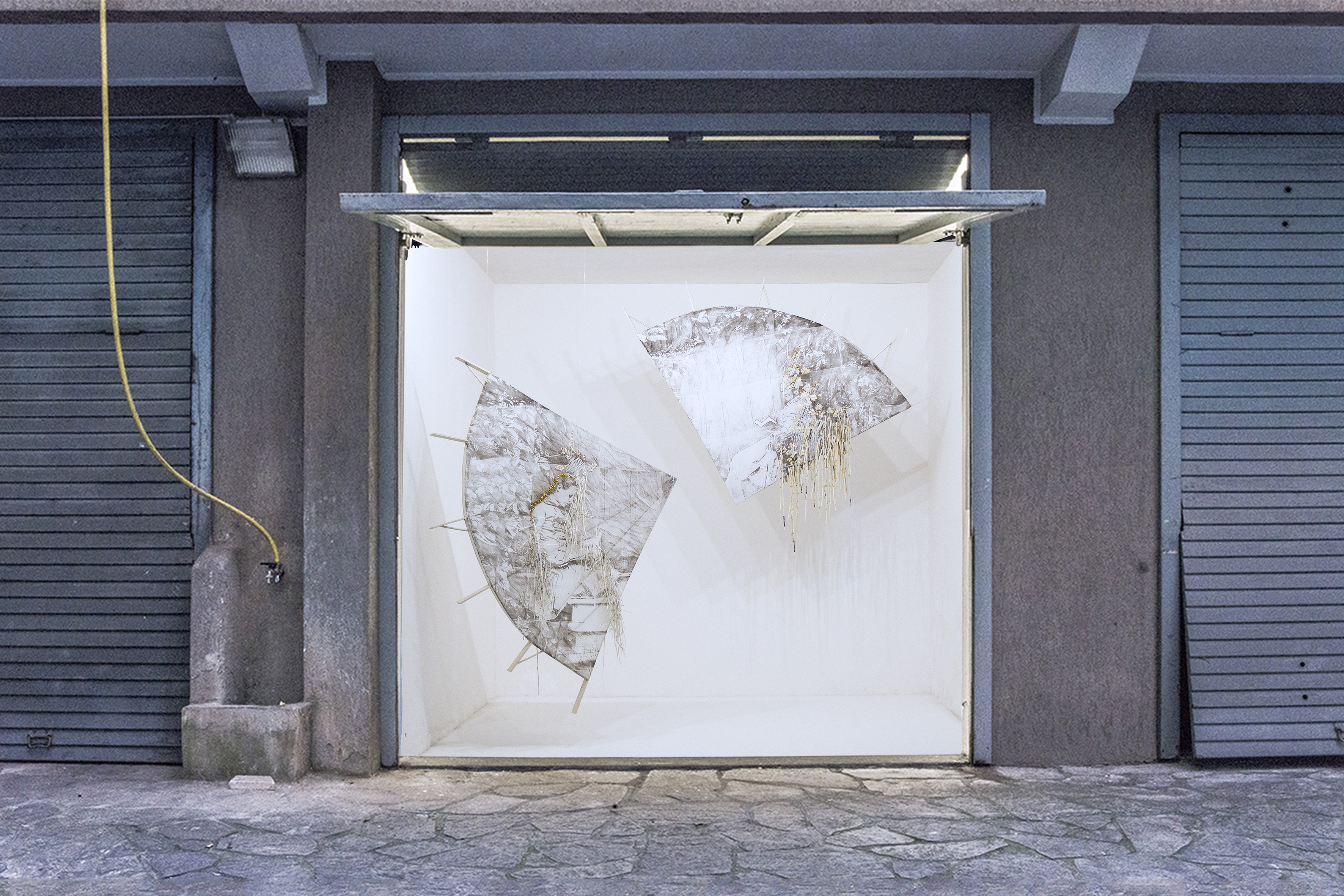
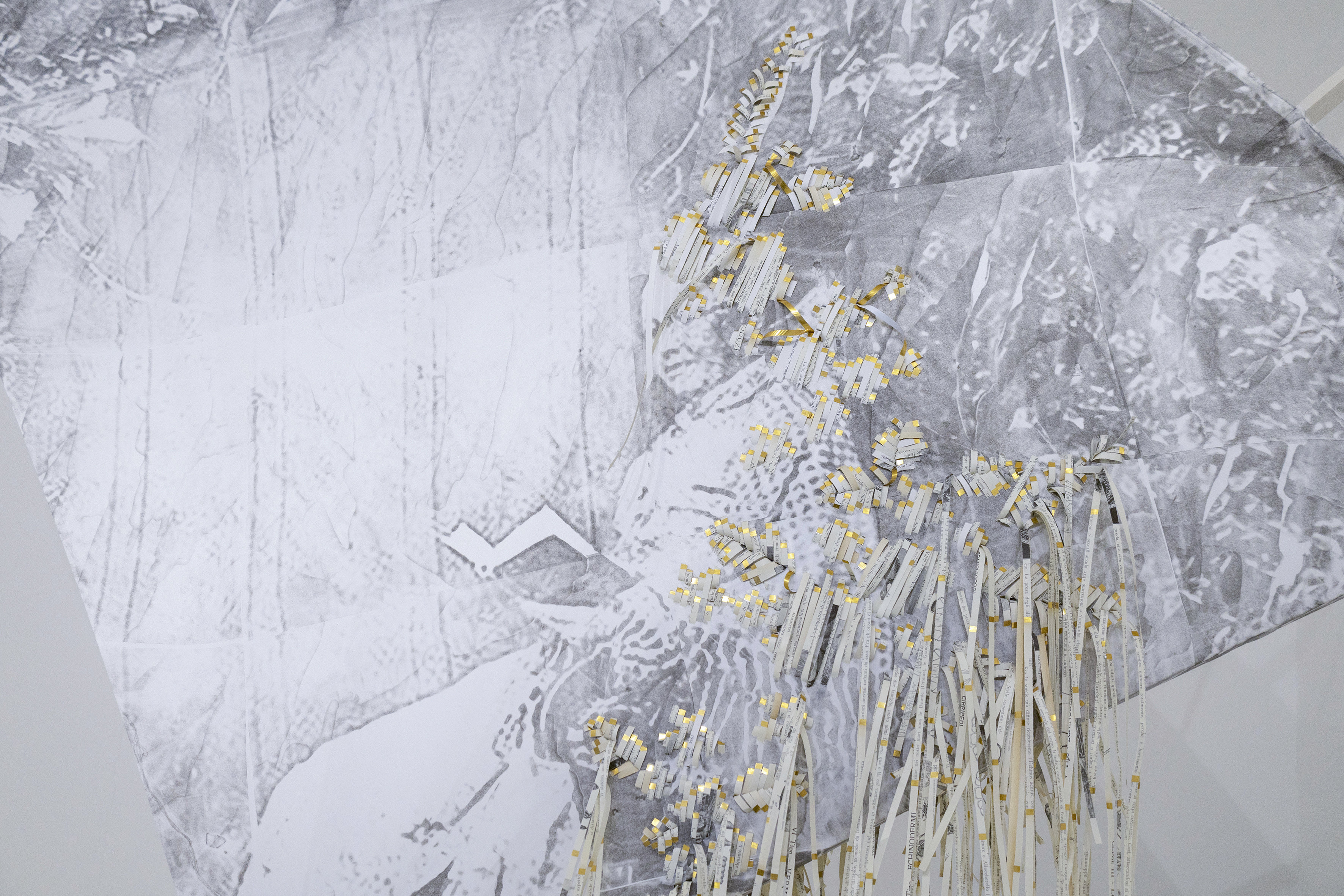
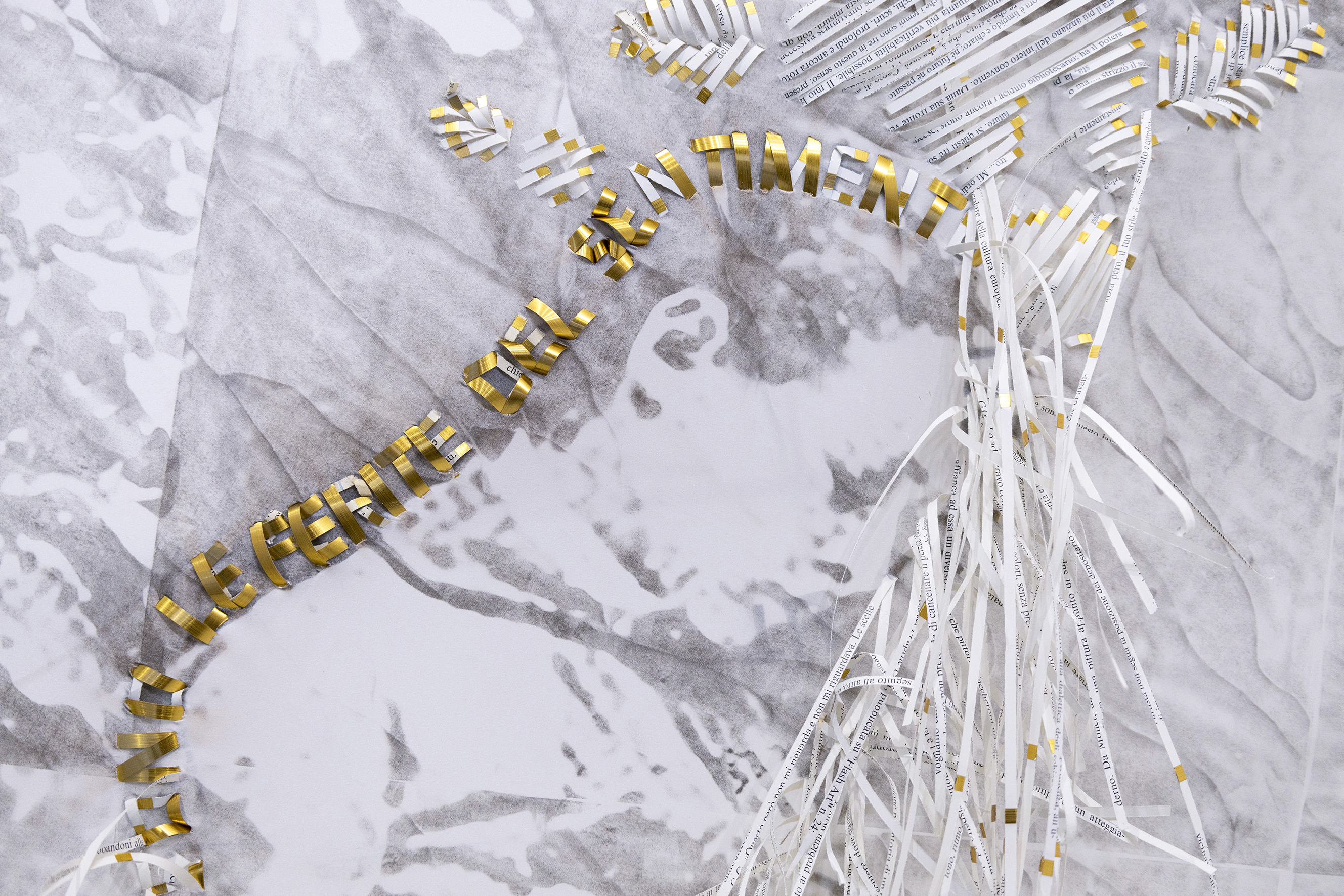
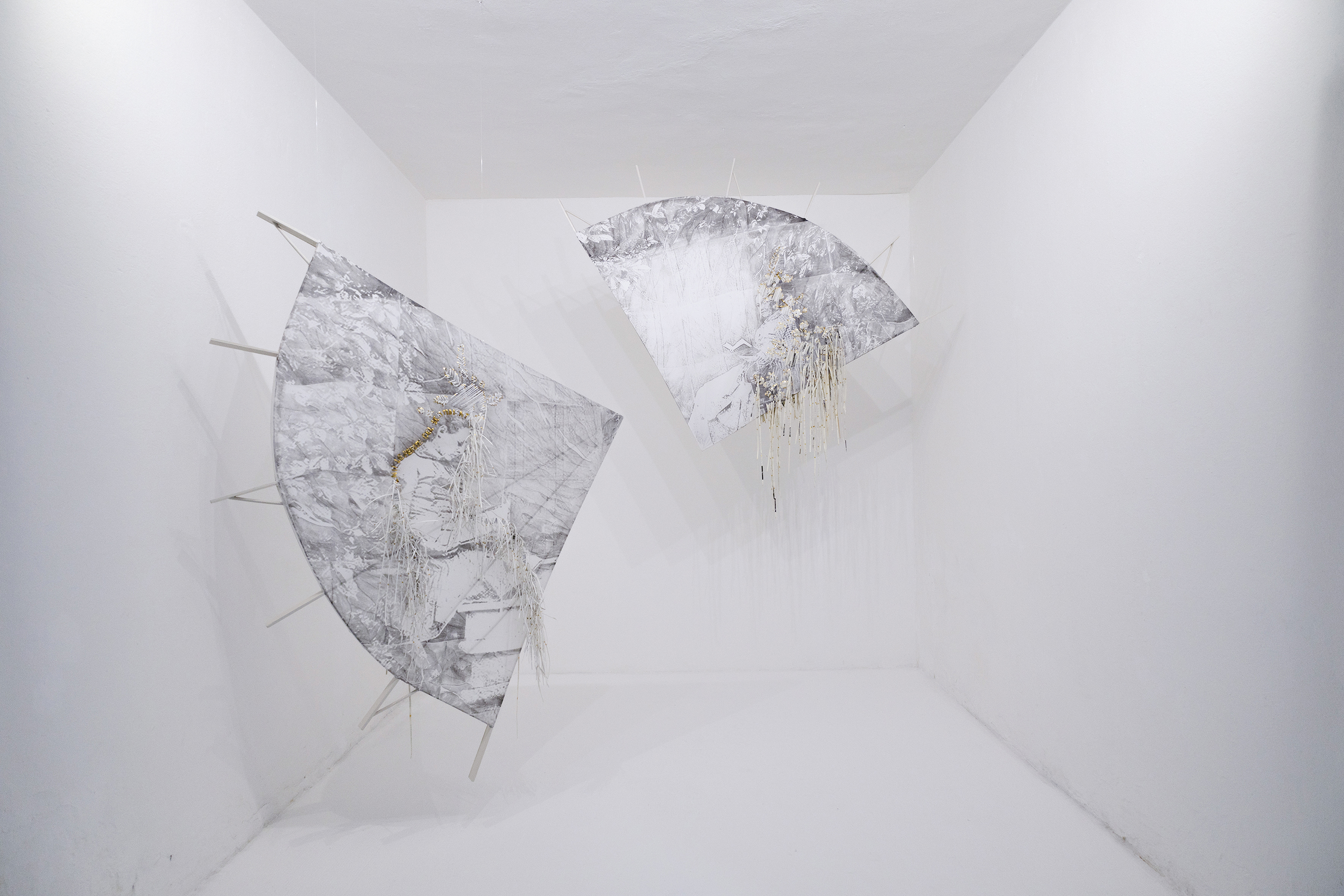

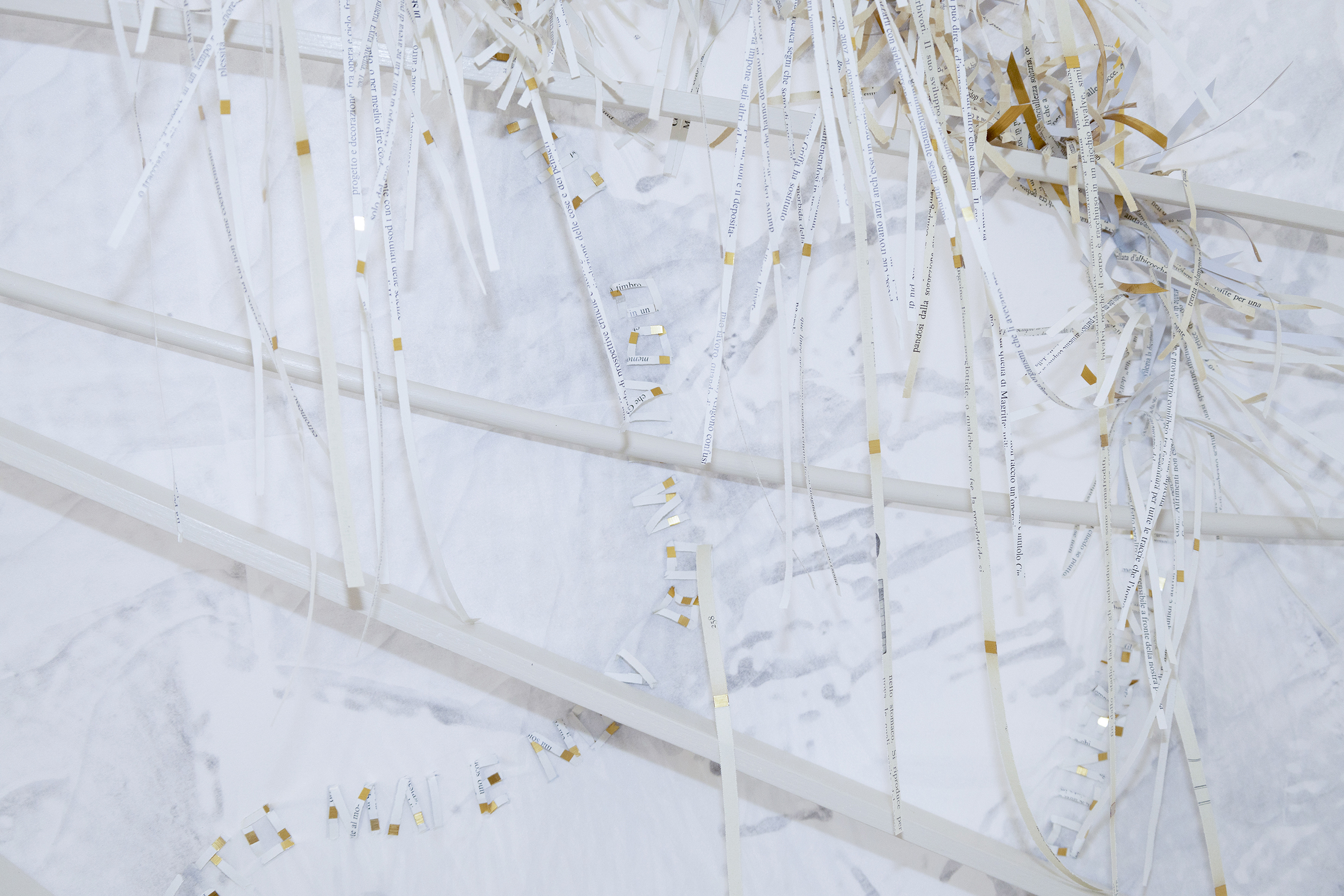
Sono le ferite del sentimento, 2023
photographic contact print on silk, pages from books, gilded aluminium, 300 x 150 cm
Ph. Valentino Albini
SONO LE FERITE DEL SENTIMENTO, 2023
Dario Picariello prende spunto dalle tradizioni dei canti popolari meridionali per situarsi come testimone, archivista, narratore e antropologo dei racconti di un mondo che solo apparentemente non esiste più, riconfigurando le storie tramandate per arrivare a una più ampia narrazione della tragicità dell’esistenza umana. La serie Cicli, avviata nel 2020, è composta da sette raccolte, ognuna dedicata a un argomento specifico della tradizione orale: l’infanzia, l’amore non corrisposto, l’amore violento, l’amore ideale, il lavoro, i riti nuziali e, infine, i riti funebri. In questa serie Picariello si avvale di fotografie prelevate da diversi archivi digitali che vengono successivamente incise con strisce di carta provenienti dalla decostruzione di alcuni romanzi destinati al macero. Una stratificazione tra immagine e parola che si intreccia e in cui emerge un’estetica seducente, utilizzata come una trappola per l’osservatore, che soltanto in un secondo momento scopre il significato dei testi celati a un primo sguardo superficiale. L’ossessione per il tema dell’identità, l’appartenenza territoriale incardinata sul folclore, l’utilizzo degli archivi come materia prima, l’uso del canto orale e il cucito presenti nel lavoro Sono le ferite del sentimento, provengono da un approccio autobiografico per poi diventare strumento di proiezione verso il presente e la collettività. Due ventagli sospesi frammentano la percezione dello spazio restituendo a sua volta una fotografia in bianco e nero scomposta, prelevata da un archivio digitale e stampata a contatto su seta, in cui la parola sovverte l’immagine. Una scena vernacolare di due donne intente nella lettura che vengono celate, occultate o eclissate dall’uso di pagine di romanzi, destinati al macero e ridotti a brandelli, come filo di cucito che si snoda per la superficie della tela e scende dal retro come frastagli di una narrazione che non vorrebbe mai finire. Una riappropriazione del testo che trova una doppia sfaccettatura attraverso forma e contenuto, oggetto e soggetto, materia e rappresentazione. La cancellazione, la contraffazione e l’alterazione dell’immagine delle donne ottiene per contrasto il risultato di evidenziare le protagoniste, risaltando come il gesto o il tentativo di rimozione aumenti la considerazione e la visibilità di ciò che si tenta di occultare. La rilevanza dell’intimità della scena, la realtà sociale che descrive, la vegetazione come cornice, le scale come componente scenografica, il portamento, i vestiti o il rapporto verticale tra le due donne cede davanti alla necessità di concentrarci su di loro. Lo stesso meccanismo scaturisce dal lavoro di recupero o riscatto di certe tradizioni orali ormai quasi scomparse che in questo caso emergono non abbozzate, non assonnate, ma sottolineate in filo d’oro come ferita mai cicatrizzata completamente. Un dettaglio che punge, un particolare che offre la chiave di lettura del lavoro e che ci indirizza verso un contesto, una storia e una tradizione locale che si congiunge con tutte quelle minoranze, diversità o alterità che hanno fondato, basato e veicolato le urgenze della propria cultura o della propria comunità di riferimento su un metodo prevalentemente orale.
Il canto popolare presente in questo lavoro riflette sul concetto di tempo, del suo scorrere inesorabile e del rapporto che abbiamo con esso. Un tempo che corrode, ma non rimuove, un’immagine che svanisce ma senza sparire completamente, un ricordo lontano che stenta a emergere e che proprio per questo ci sforziamo di voler recuperare, una memoria di cui non vogliamo o non possiamo liberarci. In questo senso, l’artista diventa un testimone che registra ciò che non c’è mai stato scritto, ferma la descrizione di un evento che sarebbe stato perduto inevitabilmente e attira l’attenzione verso qualcosa che altrimenti si dissolverebbe in una nebbia fitta, appannata e offuscata, come la nostra memoria o i nostri ricordi di cui più tentiamo di liberarci più questi ritornano persistenti, rafforzati e ostinati.
Angel Moya Garcia
-
Dario Picariello Draws inspiration from the traditions of the popular songs of southern Italy to position himself as a witness, archivist, narrator and anthropologist of a world that only apparently no longer exists, reconfiguring stories that have been handed down to arrive at a broader narration of the tragic nature of human existence. The series Cicli (Cycles), launched in 2020, is composed of seven collections, each dedicated to a specific aspect of the oral tradition: childhood, unrequited love, violent love, ideal love, labour, nuptial rituals and, lastly, funerary rites. In this series, Picariello has used photographs from several digital archives that he has incised with strips of paper taken from the deconstruction of novels destined to be pulped. A weaving stratification of word and image from which emerges a seductive aesthetic used as a trap for the observer, who only subsequently discovers the meaning of the texts concealed to an initial superficial gaze. The obsession with the theme of identity, the territorial affiliation based on folk lore, the use of archives as raw material, use of oral song and the stitching present in the work Sono le ferite del sentimento (They’re the Wounds of Feeling), come from an autobiographical approach before developing into a means of projection towards the present and the collective. Two suspended fans fragment perception of the space, rendering in turn a deconstructed black and white photograph drawn from a digital archive and contact printed on silk, in which the word subverts the image. A vernacular scene of two women reading who are veiled, obscured or eclipsed through the use of pages from novels destined to be pulped and reduced to torn strips, winding like a stitched thread across the surface of the canvas and descending from the back like the fringes of a narration you would never want to end. A reappropriation of the text that finds a dual valency through form and content, object and subject, material and representation. The cancellation, the falsification and the alteration of the image of women obtains through contrast the result of emphasising the protagonists, highlighting how the gesture of or the attempt at removal increases respect and visibility for what is being concealed. The significance of the intimacy of the scene, the social reality it describes, the vegetation as a frame, the steps as a scenographic component, the bearing, the clothes or the vertical relationship between the two women give way to the need to concentrate on them. The same mechanism derives from the recovery or redemption of certain oral traditions that have now almost disappeared and which in this case emerge neither sketchily nor drowsily, but emphasised with a gold thread as a wound never completely healed over. A detail that stings, a characteristic that offers a key to the work and which directs us towards a local context, history and tradition that connects with all those minorities, diversities or differences that have founded, based and vehicled the urgencies of their culture or their community of reference on a prevalently oral method.In this work, popular song reflects on the concept of time, on its irresistible passing and our relationship with it. Time that corrodes, but does not remove, an image that fades but without disappearing completely, a distant memory that struggles to emerge and for this reason we force ourselves to want to recover, a memory of which we do not want to or we cannot free ourselves. In this sense, the artist becomes a witness or records that which has never been written, freezes the description of an event that inevitably would have been lost and attracts attention to something that would otherwise dissolve in a dense fog, clouded and obscured, like our memory or those recollections which the more we try to free ourselves from the more persistently they return, reinforced and obstinate.
Angel Moya Garcia